Crowdfunding Backers: Innovators or Marketing Targets?
Info: 15554 words (62 pages) Dissertation
Published: 2nd Mar 2022
Introduction
The main objective of this research is to identify if crowdfunding backers are innovators or if they are influenced by marketing strategies.
- Identify what makes an innovation and the attributes of innovators
- Explore marketing strategy differences between crowdfunding platforms and general ecommerce platforms
- Determine the motivation behind backers support
This study will investigate how people interact with the concept of innovations through crowdfunding platforms (Kickstarter, Indiegogo, GoFundMe etc ). The question aimed at answering is whether crowdfunding supporters truly see the innovative side of the products they start backing up or if ultimately, they subconsciously fall into following marketing traps set to idealize products.
In order to deliver an educated response to whether crowdfunding backers are prone to notice innovations (which based on Rogers Everett’s model of diffusion of innovation segments only a limited number of individuals as innovation literate) or if they senselessly become emulators of marketing campaigns, the research for this paper will be looking at different types of crowdfunding, specifically, the most frequently used ones for innovative products and services. Furthermore, together with a survey of quantitative research and a qualitative data gathered through several interviews, the paper will provide insight into the link established between innovations and the realm of marketing.
Chapter 1. History of Crowdfunding
For the purpose of underlining the context in which innovations occur, this paper will be looking at several crowdfunding platforms and several theoretical elements that they comprise of, in an endeavour to establish if in this marketing development, backers are symbols of advancement or if crowdfunding becomes just another marketing gimmick.
According to the Oxford dictionary (2016), crowdfunding is “the financing of a new company or other project by selling shares or bonds directly to small private investors via the Internet”.( https://en.oxforddictionaries.com/definition/crowdfunding)
One of the first happenstances of crowdfunding is believed to be the funding of the Statue of Liberty’s pedestal in 1886. (Rees-Mogg, 2013). The iconic monument, which was a gift from the French, needed a structure to support its weight. The staggering cost estimation for this prospective construction ranged around $334,000; sum that through Joseph Pulitzer’s input of launching a fundraising campaign was partially achieved (~ $100.000) through the financial involvement of the public, which in return received miniature replicas of the statue. The term of crowdfunding had not been pinpointed at that moment in time. From a historical point of view it can be implied that this was the emergence of a rewards base praxis where monetary public involvement became a decisive factor in the addition of something which had not otherwise been possible to achieve as quick. In today’s mind frame, the Statue of Liberty still stands as a symbol of freedom and friendship between nations (REF https://www.howtallisthestatueofliberty.org/what-does-the-statue-of-liberty-represent/). This iconic monument remains the go-to emblem of the American people. It can be assumed that it represent the face of America; a structural innovation which superseded the marks of time. The monument was ultimately completed through the involvement and good will of American people from all social walks, where everyone fronted as much as it was available to them: from petty cash to large amounts. It has been recorded that during the fundraising campaign, one family donated the sum of $2.65 under the pattern of individual contributions:
“Philip and Eliza Bender, 50 cents each; (children) – Anna, 25 cents; Frannie, 25 cents; Leonard, 10 cents; Frank, 15 cents; Alice, 10 cents; Ralph, 10 cents; Carri, 10 cents; Miss Nicey 25 cents.” (REF http://www.bbc.co.uk/news/magazine-21932675)
Although collective fundraising efforts have existed long before the Statue of Liberty’s example (book printing, publish subscriptions to fund UK parks etc.), in this case, the appeal for funds can be drawn as a parallel to modern online crowdfunding efforts. Similarities appear under the form of several features, comprising of small donations, the timely fashion of raising the money needed as well as delivering the process under the supervision of one handler (in this case, Pulitzer’s newspaper).
In today’s society, modern crowdfunding cannot be pinpointed to a very specific moment in time. With the rise of the internet and user accessibility, it primarily gained traction in the U.S.A in 2001 through the implementation of a platform called ArtistShare. This is considered to be the first ever internet crowdfunding movement. ArtistShare launched its first project in 2003 and although it primarily targeted the music sphere, it evolved into becoming a promotional space for several other disciplines with a branched out focus to visual arts as well. Presenting itself as a rewards based platform, apart from the obvious goal of trying to raise funds for talented and original people, it also linked artists to fans and promised access into the progression of projects. Here, followers could immerse themselves into the experience of the entire creative process. In the past 14 years, ArtistShare received 10 Grammy awards and another 29 nominations. (REF https://www.artistshare.com/v4/about) The recognition gathered since the launch of the platform can be measured in the numerous examples of innovative and talented people who left their mark in the evolution of these creative mediums. Without the support of crowdfunding backers, they might or might not have been given the chance to do so.
After the success of ArtistShare, in the last decade, various other crowdfunding systems surfaced. In his book “Crowd Funding: How to raise money and make money in the crowd”, Rees Mogg(2013) enumerates several crowdfunding systems, such as:
- Donation Funding – charities, with non-commercial objectives.
Donation funding refers to collective efforts of individuals to help charitable causes
- Straight Debt Funding – peer to peer landing
Straight debt funding refers to lending money from other individuals through online platforms
- Specialist Debt Funding – alternative types of lending
Specialist debt funding provides low risk investment for lenders as there are assets backing the investment and act as a guarantee against loss
- Equity Funding – companies selling shares
Equity funding opens the gate for the public to become a shareholder with all the legal rights that it entails: dividends and right to sell
- Social Enterprise Funding – covering charities and for – profit organizations with a predetermined social purpose (First World helping Third World)
Social enterprise funding refers to the appeal of doing something good where this attitude becomes commercial in itself; it creates a strong financial context which in the long run makes companies more sustainable.
- Pledge or project funding – rewards based (Kickstarter, Indiegogo)
Pledge or project funding offers various incentives in exchange for money.
Pledge or project funding refers to large scale and sophisticated projects which evolved through the rise of the internet. Fundraising is non-restricted and can be done by anyone. This type of funding follows an exchange pattern where the promise is to deliver the product or some other incentive once it is completed. It is one of the oldest methods used by people who did not have available funds at hand, thus “pre-selling their products to generate the money needed” (Rees-Mogg, 2013).
Having determined the different kinds of crowdfunding categories, the research for this paper will offer a more in depth overview of rewards based crowdfunding system.
When referring to pledge funding, its uniqueness is measured by its simplicity, where project creators “fundraise and promise to deliver” (Rees-Mogg, 2013) and where donors have no right over the process of the venture. For a crowdfund to be successful, it needs clarity and dedication. In order for projects to get backed, fundraisers need to advocate their ventures by creating a well-constructed pitch. This can be done by creating “a video, [using] persuasive wording and [proposing] a sophisticated offer” (Rees-Mogg, 2013). The beauty of it is that rewards are made more attractive when the monetary value of the pledge is higher.
Mollick (2016) managed to analyse the impact pledge funding has had over our society by designing a survey where the researched questions looked into how crowdfunding platforms such as Kickstarter and Indiegogo changed the crowdfunding sphere. His findings discovered that 66% of creators truly believed their products were innovative, 50.1% of successful projects were considered innovative by backers and by May 2015, an estimate of 2,601 patents was filed by projects.
From a social point of view, Mollick (2016) discovered that crowdfunding platforms such as Kickstarter have managed to impact several industries:
In music, 53.1% of respondent believed that the campaign was significantly helpful in the ownership of rights to their own work; in film, 22.3% of films received distribution; in video-games, 17% of respondents affirmed that it helped them in getting self-published (Steam) while in journalism, 45% of them “said […]helped them serve an underserved audience”. (Mollick, 2016)
Mollick concludes here that the efficiency of crowdfunding bares implications that are far bigger than backers or creators. A significant amount of “innovations and social good” can be noticed, where the “money raised from campaigns [lead] to positive returns across a variety of measures”. (Mollick, 2016) (https://poseidon01.ssrn.com/delivery.php?ID=869093085017080083013011031022026124105043091018012063007122116085024118088023085119042030001020040120035093028078079114095006043061013052034028120072021004112117111009082063126103123086097081021111126082003102006028101110067108099100096066067098081087&EXT=pdf)
Kickstarter and indiegogo
Kickstarter
Kickstarter is one of the main crowdfunding platforms used to propel donation based projects. In a sense, it is a global community where creativity and creative projects can curve from ideas into reality. At this moment in time (April 2017), Kickstarter is the space where so far, 123,676 projects were successfully funded, with $3,004,626,282 pledged to support and back projects (https://www.kickstarter.com/help/stats?ref=hello).
Created by Perry Chen, Yancey Strickler, and Charles Adler, Kickstarter was officially launched on April 28th 2009 and within two years of activity, in 2011, it managed to grow from 3 people backing their first ever successful project (3 backers and raised the amount of $35.00), to 1 million backers and a community of creative people from all social spheres, even already established artists. (https://www.kickstarter.com/stories/fiveyears)
The way Kickstarter became one of the go-to crowdfunding platforms was mainly given by its “all or nothing” funding model, where unless projects would manage to attract the already established minimum monetary pledges, backers would not be charged for their venture. The upside is that by pledging to projects, people can help develop projects that are of particular interest to them. In other words, Kickstarter is a community where creatives can “[…] connect with people who can truly help [them]. There’s a class of people called ‘early adopters’, but Kickstarter backers are so much earlier than that!”( Lisa Fetterman, Kickstarter https://www.kickstarter.com/about?ref=nav)
As Perry Chen (2009), one of the co-founders of Kickstarter explains, the platform is a “newer version of the patron model, which lies somewhere between altruism and capitalism”. In other words, this statement refers to the fact that when people pledge to projects, apart from their interest in it, they are very much excited by the idea of getting something in return. This rewards based system functions in many ways, as backers can receive anything from thank you notes to mini replicas of the products. The key to a successful crowdfunding campaign, as Chen mentions, stands on six principles which for him, seem to be unbeatable:
1) Be real – “It’s humans asking other humans to help them.”
2) Have a clear goal – “It’s not sponsor my life. It’s not fund me as an artist for some vague pursuit.”
3) Offer fun rewards – “It’s about finding ways to provide value to the people who are helping you out.”
4) Show you can execute – “So anyone can throw up a page, anyone can have idea, but before people are going to open their wallets they want to know you can execute.”
5) Involve the audience – “The line between creators and the audience is getting blurred every day.”
6) Spread the word – “Your idea isn’t going to mutate out there. You’re going to need to push it out there and get your friends to help you spread the word.” “If you do these six things, you are going to have a really great crowd-funding experience.” ( Chen, 2009) https://kickstarterguide.com/files/2012/07/A-Kickstarters-Guide.pdf
Indiegogo
Much like Kickstarter, Indiegogo is a crowdfunding platform which allows people from all over the world to back projects that are of particular interest to them. From creative to entrepreneurial or cause-related projects, Indiegogo describes itself to be “an open platform dedicated to democratizing the way people raise funds” (https://enterprise.indiegogo.com/getold/wp-content/uploads/sites/2/2016/05/Indiegogo-Campaigner-Field-Guide.pdf). It was founded in 2008 by Danae Ringelmann, Slava Rubin and Eric Schell who rationalised the need for a platform that could empower creative and entrepreneurial people from all around the world to “bring their ideas to life.”( https://www.indiegogo.com/about/our-story). Based on the information provided on Indiegogo’s official website, so far, 15 million people access the platform monthly and they come from 223 countries from all over the world. In 2011, Indiegogo was even used by a couple, who after years of trying, managed to raise funds in an attempt to undergo artificial insemination. As the project was fully supported by backers, Indiegogo become the first ever platform where a baby was funded. (https://www.indiegogo.com/projects/help-the-haleys-have-a-baby#/)
The philosophy of Indiegogo revolves around the idea that it connects and unites people with ideas that matter to them while providing a “safe and secure” place for their ventures. Their statement is that of being the place where alliances are founded on trust and transparency. (https://learn.indiegogo.com/trust/)
As a comparison for what Indiegogo offers rather than Kickstarter, the checklist below offers a clear view on the perks for which Indiegogo may be a more dedicated platforms for project creators:
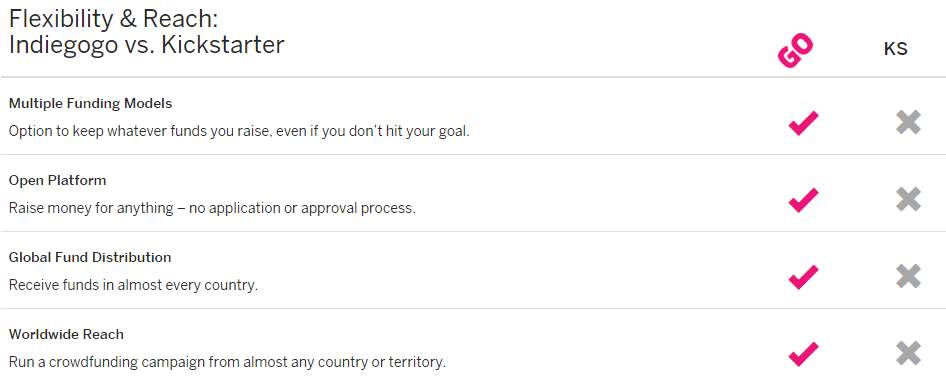
(https://www.indiegogo.com/grow/indiegogo-vs-kickstarter/?utm_campaign=iggvsks&utm_content=footer&utm_medium=footer&utm_source=igg)
This information was retrieved from the Indiegogo official website, which for the purpose of this research will not be further explored but a sceptical viewpoint will be adopted as from an analytical stance, such information will not be further investigated due to the time constraints and scope of this research paper.
Aims and Objectives
To establish if crowdfunding backers are innovators or advertising followers, this section of the research paper will pinpoint the main aims and objectives that need analysing. Firstly, the research needs to establish what innovations are and what the attributes of innovators are considered to be. Secondly, the context of marketing strategies will be examined in an endeavour to recognize the differences in their application from crowdfunding platforms to other general ecommerce platforms. Thirdly, it is necessary to determine what motivates backers to pledge and support projects, and lastly, the research paper will look into what emotional attributes can be observed in backers after participating in crowdfunding projects. In a more analytical and concise manner, the aims and objectives of this research paper are to:
- Identify what makes an innovation and the attributes of innovators
- Explore marketing strategy differences between crowdfunding platforms and general ecommerce platforms
- Determine the motivation behind backers support
Having determined the goals of this research paper, the following chapter will comprise of the theoretical framework selected in answering the question behind crowdfunding backers and their potential as innovators. This will be achieved through the presence of a literature review which will offer a step by step incursion into the aims and objectives of this paper.
Literature Review
This chapter will explore different theoretical aspects of the crowdfunding sphere in relation to innovators and marketing strategies. It will establish what innovators are and ift will offer an in depth analysis of the marketing techniques used by crowdfunding fundraisers and business start-ups in order to achieve a successful launch of their product. This section will also be looking at the ties created between crowdfunding fundraisers and crowdfunding backers and will try to determine the relationship established between the two. This literature review will focus on academic standing points such as diffusion of innovations, motivation psychology, marketing mix , online consumer behaviour– through video campaigns – and last but not least, public relations , all in an endeavour to examine how these concepts affect the crowdfunding market.
In his book “Diffusion of Innovation”, Rogers (2003) familiarises readers with the concept of innovation. He establishes the level of impact an easy to implement innovation has over its adoptability in a system where innovations aren’t necessarily ever heard of before ideas, but rather, where they present the perception of an idea as being new. For Rogers, innovation is “an idea, practice or object that is perceived as new by an individual […]” (Rogers, 2003). It does not necessarily matter if an idea is ““objectively” new” (Rogers, 2003) as long as it “seem new to the individual” (Rogers, 2003). The novelty of an idea is “expressed in terms of knowledge, persuasion or decision to adopt” (Rogers, 2003). Rogers discusses how a simplified innovation (in terms of level of understanding) facilitates the process of its adoption where if individuals recognize its innovative character, the desire for implementing it will be accelerated. With this in mind, the five perceived attributes of innovation (relative advantage, compatibility, complexity, trialability and observability) are at the forefront of Rogers’ discourse. He breaks down how and why different innovations are adopted faster than others. The example he uses revolves around the popularity of mobile phones in opposition to car seatbelts or even the switch to the metric system which took decades to be adopted.
The innovation attribute of relative advantage is given by the obviousness of its improvement to the idea it “supersedes” (Rogers, 2003). The most important factor here is that individuals recognize the potential of the innovation as being “advantageous” (Rogers, 2003). Economic factors matter but the accent falls upon “social prestige […], convenience and satisfaction” (Rogers, 2003). The next attribute of innovations is measured by the level of their consistency with “existing values”. This carries the name of compatibility and is strongly tied in with an innovation’s performance measured in time and the necessity to adopt it. Rogers emphasises the fact that “an idea that is incompatible with the values and norms of a social system will not be adopted as rapidly as an innovation that is compatible” (Rogers, 2003). This means that if an innovation does not respond to present demands, the success of its adoption can only happen when a new value system matching the incompatible innovation’s framework is adopted. This in itself is another lengthy process. The next attribute in cause, is the innovation’s complexity, which refers to the way in which it can be perceived as “difficult to understand and use” (Rogers, 2003). In this scenario, new ideas which are effortlessly understandable will perform better and will receive more interest and adoptability than complicated ones. Rogers uses here the example of Dvorak’s keyboard, which although had initially been released as an easier and faster alternative to improve and make typing faster during WW2, ulterior research proved that Dvorak’s claims for “more efficient typing are bogus, and switching layouts on the basis of speed and efficiency would not make sense.” (http://www.mit.edu/~jcb/Dvorak/)The forth attribute of innovations Rogers mentions is their trialability character, which refers to the scale of experimenting with an innovation on a “limited basis” (Rogers, 2003). This represents a first-hand interaction with the innovation and it also presents itself as an educational process, as individuals who consider adopting it, also “learn” (Rogers, 2003) by doing so. Finally, the last characteristic of innovations is given by the quality of their observability, which implies that the more an innovation is noticed and “visible” (Rogers, 2003) to individuals, the faster its adoption will occur. The main point of this argument revolves around the easiness of observing an innovation’s results. Rogers explains how with great “visibility […]” results, innovations “[…] stimulate peer discussions […] as the friends and neighbours of an adopter often request innovation evaluation information about it” (Rogers, 2003).
Moving forward from innovations, Rogers also offers a critical characterisation of innovators, specifically when explaining the advantage of encapsulating individuals in “adopter categories” (Rogers, 2003). This refers to “the classifications of members of a system on the basis of their innovativeness” as “each […] category consists of individuals with a similar degree of innovativeness” (Rogers, 2003).It is here important to mention that innovativeness represents an overall behaviour shift, “rather than just cognitive or attitudinal […]” (Rogers, 2003).
Rogers familiarises readers with several ideal types of adopters and their values (innovators-venturesome, early adopters- respect, early majority deliberate, late majority – skeptical and laggards – traditional), but for the purpose of this paper, the research will only be looking at innovators. Rogerts defines them as “Innovators: Venturesome” (Rogers, 2003), individuals with high enthusiasm (“obsession” (Rogers, 2003)) for innovations. Their concern for new ideas takes them out of their local social circles and brings them into “more cosmopolite social relations” (Rogers, 2003). They are financially stable which makes them less susceptible to monetary disasters in the event of unprofitable ventures. Another main aspect is their tech savviness as well as their sense of adventure, being able to “cope with a high degree of uncertainty” (Rogers, 2003) regarding the time and adoption of innovations”. They are also driven by the “desire for the rash, the daring and the risky”. (Rogers, 2003) Furthermore, maybe one of the most important attributes of innovators is their role of “launching new ideas […] by importing the innovation from outside of a system’s boundaries”; becoming “gatekeepers […] in the flow of a new idea […]” (Rogers, 2003) in society.
Rogers determines here how all adopter categories are a delineation of all members of a society examined through their level of interaction with innovations. He explains how “adopter distributions tend to follow an S- shaped curve over time […] to approach normality” (Rogers, 2003). The graph below will offer an overview on how in a social system, adopters are categorised:
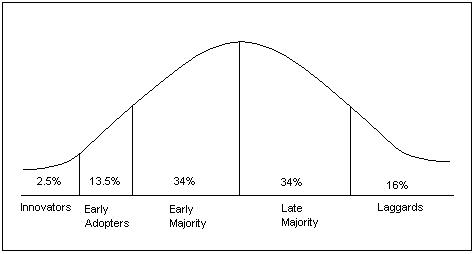
Fig. 1 – Adopter categorization on the basis of innovativeness
REF http://www.ou.edu/deptcomm/dodjcc/groups/99A2/theories.htm
(https://hbr.org/2013/10/the-five-characteristics-of-successful-innovators)
Unlike Rogers clear delineation of what innovations and innovator are, in Chamorro-Premuzic’s article , the perspective tends to bring the terms in slight ambiguity, suggesting that “there is not much agreement about what makes an idea innovative and what makes an innovative idea valuable”(Chamorro-Premuzic, 2013). He objectively presents already existent opinions on the matters of innovation and innovators, an advantageous gathering of ideas which will help further explore how innovations can be recognized as such. It is mentioned here how opinions tend to vacillate. Some studies consider “radical innovations” (Chamorro-Premuzic, 2013) – which offer sustainable competitive advantages- to be less effective than “mild ones” (Chamorro-Premuzic, 2013) – which tend to diminish uncertainty in the buyers’ market. The example used here was the launch of the iPhone 5 which did not revolutionise the cell phone market but it offered a more effective alternative to the original iPhone.
Innovators are also put under the loop in Chamorro – Premuzic’s article, who describes them as creative individuals with predefined personality traits. They appear to be “passionate and sensitive, and […] have a hungry mind: they are open to new experiences, nonconformist, and curious […] [,] personality characteristics [that] are stronger determinants of creative potential than are IQ, school performance, or motivation” (Chamorro-Premuzic, 2013). Nonetheless, creativity alone is not sufficient when trying to develop innovations. The main difference between creativity and innovation is being given by execution, the quality of shaping an idea into a successful product/service. The belief here is that “entrepreneurship is the process by which creative ideas become useful innovations” (Chamorro-Premuzic, 2013).
Apart from creativity, innovators are driven by another five main characteristics such as:
- Having an opportunistic mind-set:
This trait helps individuals recognize gaps in the market. Some people are more prone to notice opportunities than others and there is a direct link which states that opportunity is “at the heart of entrepreneurship and innovation” (Chamorro-Premuzic, 2013). The tendency of such individuals is to always stay sharp and in search for novelty.
- Formal education or training
This section refers to cultured and knowledgeable individuals who use their insight to interpret opportunities.
- Proactivity and a high degree of persistence
These attributes help in the process of exploiting the aforementioned identified opportunities, implying that innovators who possess these traits are more “resilient and energetic” (Chamorro-Premuzic, 2013) than others
- A healthy dose of prudence.
Prosperous innovators are organized, cautious and disinclined to take risks (unlike Rogers’s determination of innovators as venturesome risk driven individuals, this refers to successful innovators who although move in a sphere where in the process of business formation the probability of risk taking is higher, this aspect is not necessarily linked to business success).
These are defined by the networks of relationships among people who live and work in a particular area, enabling innovators to function more effectively. These resources are constantly in play when trying to build lasting alliances. Oddly enough, even though innovators are glorified as “independent spirits and individualistic geniuses” (Chamorro-Premuzic, 2013), innovation tends to mostly be the product of team work.
Possessing these five main characters that are considered to be the advantages of a successful innovator’s mind do not necessarily guarantee triumph. Chamorro-Premuzic hints that in the path towards successful innovation, all these features necessarily require to be accompanied by vision as well as the ability to drive others towards innovation.
In other words, innovation requires a culture determined by team work, vision, encouragement and proactivity in order to lead to growth. As Premuzic states himself, “what matters is the ability to generate many ideas, discover the right opportunities to develop them, and act with drive and dedication to achieve a meaningful goal” (Chamorro-Premuzic, 2013)
This section of the research paper offered an investigation into what theorists consider to be an innovator. With specific denominators such as their venturesome spirit, tech-savviness, their capacity to detect opportunities and seize them together with their risk taking spirit, innovators are the sign of modernization as they are the first to acknowledge the potential of products and services. In crowdfunding, innovators are the first contact persons between project creators and external responses to their project, thus becoming the representatives for assessment, experimentation and ultimately, progression. Drawing from these traits, the next section of this paper will further analysed how marketing strategies in crowdfunding apply their ecommerce methods to ensure a successful campaigning, tailored to the interests of crowdfunding platform (Kickstarter and Indiegogo) backers, regardless of the adopter category group they belong to.
Marketing strategies used in crowdfunding
When referring to the marketing strategies used in crowdfunding, the following passage will explore the different techniques advertisers use in order to grab the everyday consumer’s attraction to goods and services. This section will also explore how these techniques do not have the same impact over crowdfunding projects.
According to (http://www.jagsheth.com/wp-content/uploads/2015/12/Consumer-Resistance-to-Innovations-The-Marketing-Problem-and-its-Solutions.pdf)’s article, people living in developed countries are usually pro innovations and see the benefits of technological advancement. However, he points out several reasons why consumers can be resistant to changes. He describes how innovation can bring drastic changes to their daily lives and how it can challenge their belief structure (http://www.jagsheth.com/wp-content/uploads/2015/12/Consumer-Resistance-to-Innovations-The-Marketing-Problem-and-its-Solutions.pdf). http://www.jagsheth.com/wp-content/uploads/2015/12/Consumer-Resistance-to-Innovations-The-Marketing-Problem-and-its-Solutions.pdf Also points out that out of all, innovator adopter groups are the least resistant but even they show some sings of defiance. This reaction can be more so noticed in the other adopter groups (the everyday consumers) who are even more reluctant to embrace new developments. To combat this resistance, crowdfundees use various marketing techniques to promote their products.
E. Jerome McCarthy’s (REF) marketing mix is the foundation on which most of the project marketing strategies are based. His theory puts forward four important elements: price, promotion, place and product. In the case of crowdfunding, the product is sometimes not yet developed fully and only the concept is proposed. This sometimes can be a disadvantage as campaigns work on the premise of promise. Moreover, the price element differs on crowdfunding platforms than traditional online retailers as it has reward tiers. (Rees-Mogg, 2013) in her book “Crowdfunding: How to raise money and make money in the crowd”, highlights the fact that other incentives can be offered besides the product itself. These incentives sometimes don’t even include the product (thank you note, signed photo of the team, etc.), therefore, helping raise capital before going to production. When it comes to promotion, content marketing is king and by the use of video campaigns, attention towards the promoted products spikes a lot faster. If a picture is worth a thousand words then a minute of video is worth 1.8 million according to Forrester’s research (http://www.marketwired.com/press-release/a-minute-of-video-is-worth-18-million-words-according-to-forrester-research-1900666.htm). Videos are the first thing users see. Fundraising campaigns that use video in their promotion are more likely to succeed than the ones that don’t (50% vs 30% (http://mashable.com/2012/05/13/kickstarter-tips/#dI5REyPo05qW). (Rogers, 2003) points out that innovation is adopted at a faster rate if the results are visible. This could be achieved with clear informative video content that features the product in action. Finally, distribution also matters as backers are keen to get their hands on the project they are funding. In the statement released by Kickstarter, 9% of projects failed to deliver and only 65% of backers reported that they received rewards in a timely fashion. (https://www.kickstarter.com/fulfillment). It is really important to assure backers that their reward will be delivered on time. All four elements are crucial to the project’s success but they differ from traditional platforms as campaigns work on the base of promise and a high level of trust is required from the consumer. This requires a carefully crafted marketing communications plan.
In order to assure the consumer that their product is on the right track and will be delivered on time, crowdfundees aim to establish a dialogue with the supporters. This can be achieved through consistent updates on their project throughout campaign, newsletters and press releases. A well-established two way conversation can add value to the product without enhancing any features (http://www.emeraldinsight.com/doi/abs/10.1108/08858620410523990). In her book (Rees-Mogg, 2013) stresses the importance of keeping funders up to date with the progress of the project. Most importantly, letting them know if something is not going according to plan, “Give them the good news quickly and the bad news quicker”(Rees-Mogg, 2013). Well established dialogue could also be utilised to gather feedback on projects. In order to achieve wanted results, the most successful campaigns conduct surveys and even ask for help from their pledgers. (Rees-Mogg, 2013) suggests that creating social media profiles helps keep consumers happy and informed. By establishing and maintaining dialogue, crowdfundees can look at their project from the perspective of the consumers. (Kotler, 2013) stressed the importance of integrated marketing communications as it gives a “way of looking at the whole marketing process from the viewpoint of the customer”. This is really important as some of the crowdfunding products are in their late development stage, where feedback is really important.
When referring to crowdfunding projects, the majority of advertised products are still in the development stage; Kickstarter and Indiegogo become the testing grounds for new ideas and products, therefore, from the consumer’s point of view, trust plays a huge role. Backers are expected to take a risk when it comes to investing in Kickstarter and Indiegogo platforms; hence, in return for donations, they offer “rewards” (Kickstarter) or “perks” (Indiegogo) meant to further solidify the confidence between pledgers and fundraisers. This is one of the biggest differences between crowdfunding and other online retailers who do not offer the same kind of reassurance reciprocity.
Additionally, another marketing strategy used in crowdfunding is given by the implementation of public relations (PR) which play a huge role in crowdfunding projects. In order to gain traction, crowdfundees turn to professional agencies to generate buzz behind their product. According to Edward Bernays, one of the pioneers of PR: “The three main elements of public relations are practically as old as society: informing people, persuading people, or integrating people with people.” (http://www.barnesandnoble.com/w/public-relations-edward-l-bernays/1018936330#productInfoTabs ). In her book (Rees-Mogg, 2013) suggests that creating a PR campaign at the start of the crowdfunding venture helps build audience. This practise of using PR as a tool to inform and convince people is widely used by other traditional retail platforms and is not unique to the crowdfunding phenomenon.
Most marketing strategies used by crowdfundees are similar to what other retailers use to promote their products but the findings of this section have established that crowdfunding platforms have unique particularities. The foundation of these particularities is produced by the presence of a trust based relationship with backers, a sense of community between peers and active consumer participation during the development process through suggestions and comments.
Through the marketing strategies previously discussed, this section aimed to explain how advertisers engage with their audience in order to attract consumer’s attention. By promoting retailing specifics given by price, promotion, place, and product with the implementation of video campaigns and PR, marketers aim to create a tempting idealization of the services they are promoting. In the crowdfunding sphere, the success of a project is ensured by other factors: the main criteria for triumph are dependent upon the presence of trust and the backer’s immersion in the creative and development process.
Having determined the difference between how marketing strategies aimed at everyday consumers differ from crowdfunding support rationale, the following subchapter will offer insight into the ticks that motivate crowdfunding users to back projects.
Psychology and motivation
Since the definition of an innovation and innovator has been established and the way crowdfunding operates has been analysed, this paper aims to explore the motivation behind crowdfunding backers. This section will analyse the psychology behind project funding, the management of the marketing campaigns, aspects of theoretical framework of economics and how consumers interact with informational technology.
Gerber and Hui’s (2012 https://pdfs.semanticscholar.org/00f9/b53984a636889a418226846069de8a76712b.pdf) article entitled “Crowdfunding: Motivations and Deterrents for Participation” was used here to determine the main behaviourism motivations that make individuals offer their support when engaged in backing crowdfunding projects; according to them and together with the findings of other relevant theorists in the field, crowdfunding can be segmented to the following elements – philanthropic practises, consumer behaviour within online communities, peer to peer lending and online peer production.
Philanthropy behaviour
Many of the crowdfunding projects are framed as philanthropic therefore it is important to analyse the altruistic features behind giving to a “greater” good. In his paper “Tightwads and Spendthrifts” (Rick http://www-personal.umich.edu/~prestos/Consumption/pdfs/RickCryderLoewenstein2007.pdf) argues that decision makers are not immune to emotional influence and do not base their decision solely on practical grounds. The anticipated emotions that come with the purchase of products can sometimes be a final decisive factor. (Rick) As online philanthropy is sometimes associated with financially supporting a human cause, crowdfunding can be used as a self-indulgent happiness machine. (https://pdfs.semanticscholar.org/00f9/b53984a636889a418226846069de8a76712b.pdf ). The perceived emotional benefits of supporting a project are a major motivator for backers. The aforementioned marketing practises show that for the majority of times, in order to increase audience interest, crowdfundees appeal to the emotional side of participators. Sympathy and empathy play a huge role here(Rick), and the guilt of not giving [Cialdini et al. 1981] and not being a part of the community contributes to the decision making process. According to an article from ideas42 organization (BEHAVIOR AND CHARITABLE GIVING, n.d.) ( http://www.ideas42.org/wp-content/uploads/2016/06/Behavior-and-Charitable-Giving_ideas42.pdf), people regularly tent to make decisions that emulate their general overview of a subject based on their feelings towards it (positive or negative). This presumes that they rely on external factors when engaged in a decision making activity where positive emotions encourage and strengthen community driven behaviour. As social creatures, people are highly influenced by social norms and when they affiliate with larger groups, they observe and mimic the mass behaviour. It is safe to assume here that people have the predisposition to admire and support other people who share the same values and interests as them. (http://mc7290.bgsu.wikispaces.net/file/view/McMillan_1986.pdf) However, this theoretical framework applies more to charities, which are relatively cheap projects that don’t require a lot of funds. When it comes to more expensive projects, social status [Becker 1974) and belonging [Maslow, 1943) might be the driving force. Relationship marketing also needs to be considered as the crowdfunding project managers usually try to establish a bond between two parties. (http://www.emeraldinsight.com/doi/abs/10.1108/00251749410054774).
Consumer behaviour online
Essentially, crowdfunding is just another market where creators advertise and sell their products to consumers. Therefore, the marketing theory proposed by Laudon and Traver (2009) (http://dl.acm.org/citation.cfm?doid=2562181.2530540)and which is specific to e-commerce is applicable through a framework that compares online and offline consumer decision making. Online consumers who want to buy a product will analyse the brand and product characteristics. Moreover, website features, capabilities of the firm and consumer technical skills play a big role (Laudon and Traver , 2009). If a website is lacking features or is simply too slow it can have a negative impact on the consumer.
Affective processing and participation (https://www.macfound.org/media/article_pdfs/JENKINS_WHITE_PAPER.PDF ) contributes to the decision making process together with the presence of a variety of choice (which sometimes is just an illusion) (https://faculty.washington.edu/jdb/345/345%20Articles/Iyengar%20%26%20Lepper%20(2000).pdf)which is specific to crowdfunding. The biggest difference between crowdfunding and any other online retailer is that of being able to buy products or services in advance; i.e. backers place a lot of trust into the project. People’s trust in online shopping has been growing steadily due to new security measures implemented by companies.
Online Peer to peer lending
Another similar phenomenon to crowdfunding is peer to peer lending. It works in an auction system where individuals bid on microloans sought by other borrowers. Supporters take a risk when giving money to the creator. Researchers [Lin et al. 2009] and [Potzsch and Bohme 2010] found that people are more likely to lend money to peers who share personal information and who create a bond between two parties. All this creates a positive perception of the borrower.
Online Peer Production
Crowdfunding platforms rely on the involvement of the “crowd”. This could be compared to the crowdsourcing phenomenon, where a project is dependent on the input of the peers. One of the biggest crowdsourcing projects that ever succeeded is Wikipedia. In his paper (http://citeseerx.ist.psu.edu/viewdoc/download?doi=10.1.1.457.1402&rep=rep1&type=pdf ) lists six motivating reasons behind participation in Wikipedia’s expansion, where altruism is one of the main characteristic that stands behind its success. He also points out reciprocity as a big driving force for Wikipedia’s rise. This is similar to altruism but with an expected benefit in return. In his paper, Kuznetsov draws a parallel between Wikipedia’s content contribution and the act of giving out birthday gifts, where the altruistic motivation behind it is expected to be answered with generous reciprocity. (http://www.journals.uchicago.edu/doi/abs/10.1086/406755) even goes as far as saying that every altruistic behaviour eventually grows into reciprocity, for example, when sharing knowledge or helping friends in need. He later describes how this has evolutionary advantages which help shape communities. According to (http://citeseerx.ist.psu.edu/viewdoc/download?doi=10.1.1.457.1402&rep=rep1&type=pdf) the sense of community and shared common goals contributed to the success of Wikipedia. The project attracted likeminded people who had the same set of values and who tackled problems that they encountered throughout the process of its elaboration. Participating in group projects and building the right kind of reputation plays an important role, as contributors try to achieve a level of respect and trust among their peers. Lastly , http://citeseerx.ist.psu.edu/viewdoc/download?doi=10.1.1.457.1402&rep=rep1&type=pdf points out that autonomy and freedom of decision making motivates Wikipedia’s contributors.
Having examined what different affects determine backers’ motivation, this subchapter established that when engaged in the activity of backing projects, individuals are mostly driven by varied emotional aspects. Whether participating to feel like they are part of the community, be recognized or collect rewards, with the example of the rise of Wikipedia, the backing community seems to also be motivated by the desire to learn, to collaboratively solve problems and be able to participate outside the confines of ample financial affairs.
Methodology
Introduction
This chapter will employ and rationalize the research methods chosen to answer the objective of the research, which is to establish if whether crowdfunding backers are innovators or if ultimately, they become exploits of marketing strategies.
For the purpose of establishing such fact, this chapter of the paper has been divided in 7 subchapters aimed to explain the process of the chosen investigation methods.
It will rely on the findings of both the quantitative and qualitative data used in the process of analysing the goal of this research and will try to establish the positioning of innovators in the crowdfunding scene.
According to C.R. Kothari’s book entitled “Research Methodology: Methods and Techniques”, methodology is: ‘’a way to systematically solve the research problem. It may be understood as a science of studying how research is done scientifically.’’ (Kothari, 2004). For this paper, the chapter will illustrate the research framework structured around Saunders’ (2012) onion model while looking at the philosophical arguments behind it and also the way in which the data will be approached.
Research philosophy
Having established the goal of this chapter, this section will examine the theoretical and philosophical framework that stands behind it. As the “research philosophy deals with the source, nature and development of knowledge” (N. Bajpai, 2011) (https://books.google.co.uk/books/about/Business_Research_Methods.html?id=wY2bSaEm8l8C&redir_esc=y), Saunders’ onion principle will be applied as each step of the research process will rely on assumptions regarding the sources and the essence of the reasoning which stand as basis for the research strategy.
The following chapter will familiarise readers with of the main paradigms in research philosophy (ontology, epistemology and pragmatism) but for the purpose of this paper, it will only be offering a more in-depth analysis into the concepts of pragmatism and the epistemological branch of interpretivism. These methods were chosen as they are the most applicable approaches to determining the goal of the paper, which is to establish if crowdfunding backers are innovators or marketing pawns.
Research philosophy can be sectored into two categories: ontology and epistemology.
Ontology
As per Saunders’ book, ontology can be defined as the branch of philosophy concerning the nature of reality. This implies that here, researchers can formulate questions and assumptions regarding the world around them and their dedication to their particular perspectives. In a sense, ontology can be defined as “the science or study of being”[ Blaikie, N. (2010) “Designing Social Research” Polity Press] and while it concerns the nature of reality, as a research method, ontology encourages analysts to put under the loupe their thoughts about society, the manner in which the world works, how it is designed and how all these aspects impact everything surrounding them.
Ontology itself can be divided into two sections- objectivism and subjectivism- each accepted as to accomplish “valid knowledge by researchers” (Saunders,2012).
In objectivism, the position of social actors and their viewpoints are independent from the external reality in which they exist. This means that the social sphere and its implications are independent from the perspectives of individuals who possessing the capacity to shape the world by reflecting on their situation and the choices available to them. In opposition to this concept, subjectivism depicts reality on the basis of assumed roles of individuals.
Epistemology
Following Saunders’ theory, epistemology is a paradigm that concerns “what constitutes acceptable knowledge in a field of study”. (Saunders 2012). In philosophy, epistemology is the actual study of knowledge. This affirmation implies that researchers need to look at the process of knowledge and differentiate between what is known and what can be known. By using “[…] reason, […] senses, the testimony of others, and other resources to acquire knowledge”, researchers can become aware of the existing knowledge limitations and the means available to overcome them. (http://www.iep.utm.edu/epistemo/) Epistemology can also be divided into several branches, such as:
Positivism – the philosophy which states that only observable phenomena can lead to the extraction of credible data and have the character to then be further analysed (Saunders, 2012)
Realism – the philosophy which states that there “is a reality quite independent of the mind” (Saunders, 2012) where much like positivism, the development of knowledge can only be a granted by a scientific approach. This approach can furthered be sectioned into two mannerisms: direct realism – “what you see is what you get” (Saunders, 2012) or critical realism – where human experiences are just sensations, “the images of things in the real world, not the things directly.” (Saunders, 2012)
Interpretivism – the philosophy that advocates the need for the researchers’ understanding of the “differences between humans and their role as social actors” (Saunders, 2012). Saunders draws here a parallel between society and the metaphor of the theatre, where individuals act according to their interpretation of things. The status of social actor implies becoming immersed in a belief system that can be intrinsic as much as incepted, while performing the given social roles through the perspective of personal interpretations of their meanings.
As interpretivism is one of the two chosen methods of analysing the research data, Saunders explains that it is constructed upon two intellectual traditions: phenomenology (the way in which […] humans make sense of the world around [them] Saunders, 2012)) and symbolic interactions (where humans are in “continual process of interpreting the social work around [them][…][and where they] interpret the actions of others with whom [they] interact[…]. [This] interpretation leads to [the] adjustment of [people’s] own meanings and actions.” (Saunders, 2012))
To prove this point, Levinas’ philosophical stance on alterity can be mentioned, where the interaction between individuals is based on the principle of “exteriority in relation to “The Other”. (https://www2.le.ac.uk/departments/management/documents/research/research-units/cppe/conference-pdfs/levinas/lim.pdf) In a sense, what Levinas is advocating for is the human principle of interaction: through alterity, individuals are not singular, but they become so by emulating and accepting the traits and characteristics of others, as this is the process of becoming whole. Here, the process of interpretation becomes infinite.
Much like Levinas but less theoretical, in Saunders’ opinion, crucial to researchers should be the trait of adopting an “empathetic stance” (Saunders, 2012) where the focus should be on understanding their subject’s view on the world as if it were their own. Saunders also explains the importance of the interpretivist perspective as being “highly appropriate” (Saunders, 2012) in fields such as business and management where people from different backgrounds come together at “a specific time” (Saunders,2012) and where the accent falls upon aspects tied in with organizational behaviour, marketing or human resources. These can be very “unique […] and complex” situations.
Having established what differentiates ontology from epistemology and establishing interpretivism as one of the research philosophies chosen, the following section will offer an incursion into pragmatism, which is the main paradigm the study will be using when analysing data.
Pragmatism, as Saunders defines it, is the concept which stipulates that “concepts are only relevant where they support action” (Saunders, 2012). This implies the research questions to be the most important element of the analysis. It is crucial to mention here that this pragmatism is the best way of investigating when more than one research philosophies applies to the study. As multiple methods of analysis can be used, “for pragmatists, the importance of the meanings of an idea (or a research finding) are its practical consequences” (Saunders, 2012). In other words, pragmatists are aware of the fact that when interpreting the world, sometimes one point of view is not sufficient to draw a generally viable conclusion. Thus, the method/methods they apply are the ones that can offer a “credible, well founded, reliable and relevant data to be collected that [will] advance the research” (Kelemen and Rumens, 2008)
Research Approach
This paper will rely on an inductive research approach which by lending itself to the literature review provided, enabled the researcher to tailor the research questions to the hypothesis of the research, making the data easier to analyse. This study used interviews and a survey to help answer the research question.
Based on Saunders’ theoretical framework, research approaches can have two branches:
Deductive, which can be considered pure scientific research, as it “involves the development of a theory that is then subjected to a rigorous test through a series of propositions […] where laws present the basis of explanation[…] and permit them to be controlled” (Saunders, 2012)
And
Inductive, with the purpose of “understanding better the nature of the problem […] [as the] task would be to make sense of the […] data […] collected, through [personal] analysis” (Saunders, 2012).
This approach ties in with the nature of this research as it implies that the “theory would follow [the] data rather than vice-versa, as with deduction” (Saunders, 2012). Induction can be used as a synonym for how individuals portray the world in which they live in. It lends itself to explaining how people perceive their interactions and experiences, where there is nothing rather mechanical about their viewpoints. The inductive approach takes into consideration the “context in which […] events take place” (Saunders, 2012), rather than a critique that does not permit the existence of “alternative explanations of what is going on” (Saunders, 2012).
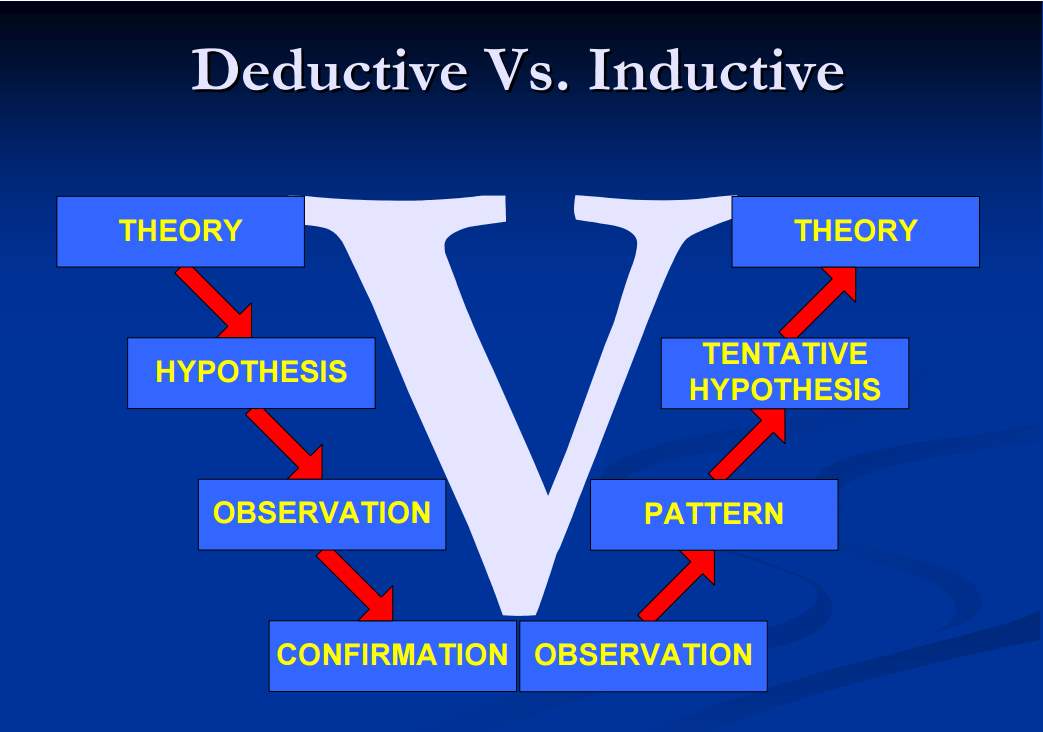
(http://www.drburney.net/INDUCTIVE%20&%20DEDUCTIVE%20RESEARCH%20APPROACH%2006032008.pdf)
Research Design
In accordance to Saunders’ beliefs, Isaac & Michael state that a survey is the method “to answer questions that have been raised, to solve problems that have been posed or observed, to assess needs and set goals, to determine whether or not specific objectives have been met, to establish baselines against which future comparisons can be made, to analyse trends across time, and generally, to describe what exists, in what amount, and in what context.” (Isaac & Michael, 1997,) (https://www.mitre.org/sites/default/files/pdf/05_0638.pdf)
As the purpose of this research is to determine if crowdfunding backers are innovators, a quantitative approached is applicable to this investigation section. Quantitative research refers to “any data collection techniques” (Saunders, 2012) and relies on numbers and their general analysis. Thus, it is important to make sure that the questions used in the quantitative research design are clear and unbiased so that the survey used when collecting the needed data can deliver an objective generalisation of the gatherings.
Since surveys can deliver information regarding opinions which otherwise are hard to attain (McIntyre, 1999), the main factor which needs to be taken into account is the fact that they only provide approximations rather than “exact measurement” (Salant & Dillman, 1994) https://www.mitre.org/sites/default/files/pdf/05_0638.pdf.
In light of this, apart from the qualitative data gatherings obtained through a survey, this research will also incorporate and analyse the findings of several interviews, which will be carried out in the form of qualitative data from a much smaller sample.
Qualitative data is identified within the interpretive philosophy (Saunder, 2012) as researchers need to understand the nature of the study. Researchers need to establish trust and participation which is achieved by gaining personal access to interviewees. Moreover, it implies building a rapport with them. For this reason, the research paper will also use interviews as one of the data collection designs .
The judgement for collecting both qualitative and quantitative data is pinpointed under the term of the “mixed-method” approach (Saunders, 2012). This relies on the researcher’s awareness to correctly combine the gatherings of the two methods; as such, this investigation will complement the findings of the quantitative data (survey) with the qualitative approach of data collection (interviews), in an endeavour to observe the crowdfunding backers’ positioning as either innovators or subconscious marketing consumers.
When referring to mixed methods of research, there are multiple variations on how the analysis can be combined and either process leads to them being depicted as either a fully integrated mixed method of research or a partially integrated mixed method of research. With consideration to the scope of our investigation, the partially integrated method applies, where the analysis will be done at a particular stage of the process (after the complete collection of data from both the survey and the interview) and not “at every stage” (Saunders. 2012) of it, which is specific to the fully integrated method.
Research Strategy
The research strategy creates a bridge between the philosophies chosen when undergoing a study and the methods adopted to collect and analyse the data (Saunders, 2012). The implementation of the research strategy facilitates the researcher’s path to arrive to an answer that determines the scope of a study. This translates to the research strategy becoming a plan of how to interpret the research questions.
As it was concluded so far in the paper, when analysing data, various methods can be applied at the same time (quantitative, qualitative or mixed), as such, it is important to mention that when undergoing a study, a method should not be considered unequivocally superior to another. As Saunders explains, one of the main particularities is not to attach labels “for their own sake” as well as avoiding to “try to be methodically aloof “since the goal is to “achieve a reasonable level of coherence” (Saunders, 2012). Thereof, it can be said that the research strategy’s aim is to allow the research to answer the questions and meet the objective of the study; when doing so while embracing the outcome from a more pragmatic viewpoint, this ultimately leads to a nonpartisan interpretation of the data.
As Saunders explains, research strategy implies the existence of several approaches when collecting data. These can be determined through experiment, survey, interview, case study, narrative inquiry etc., but for the purpose of this paper, the methods chosen were via survey and interviews.
Survey
The survey strategy is synonymic with answering questions that relate to the nature of the research by aiming to respond to questions that offer a result for “what, who, where, how much and how many “(Saunders, 2012).They are mainly attributed to the quantitative research design as they rely on numbers and their general analysis. Surveys are a popular way to collect data as they are standardised and easy to compare. This particular strategy simplifies the researcher’s work as it offers more control over the entire research process. As Saunders puts it, “when sampling is used” the findings collected are “representative of the whole population […] at a lower cost” (Saunders. 2012) than retrieving the data from the entire population. In a sense, surveys are cheap and effective ways to collect the views of the subjects while having the advantage of being “easy to explain and understand”. Nonetheless, the response rate depends very much on the structure of the survey questions. In a sense, researchers rely on the good will of participants to respond and therefore, limits have to be applied to the length of the questionnaire.
Interview
The research interview implies “a purposeful conversation” (Saunders, 2012) between two parties – researchers and interviewees. As in any conversation, it is necessary for researchers to establish a connection with the participant(s), to ask clear and concise questions and to thoroughly concentrate on the progress of the discussion. The purpose of an interview is to “gather valid and reasonable data” (Saunders, 2012) while offering the possibility of interviewees to “speak in their own voice and express their own thoughts and feelings” (Berg, 2007: 96). (https://www.researchgate.net/profile/Hamza_Alshenqeeti/publication/269869369_Interviewing_as_a_Data_Collection_Method_A_Critical_Review/links/55d6ea6508aed6a199a4fd34/Interviewing-as-a-Data-Collection-Method-A-Critical-Review.pdf)
As Saunders clarifies, interviews can be either formalised or structured (when delivering standardised questions applicable to each participant) or they can be informal and unstructured discussions (Saunders, 2012). The approach depends entirely on the degree of formality in question. The levels of formality define the typology of the interviews. These typologies include several natures of interviews – structured, semi structured and unstructured but for the purpose of the research paper (defining the stance of crowdfunding backers as innovators or marketing targets) the manner chosen is defined by the implementation of semi-structured interviews.
Semi-structured interviews are typically considered to be extensions of the qualitative research method where researchers have at hand “a list of themes and some [possible] key questions” (Saunders, 2012) that need to be covered, where there isn’t a predetermined construction attributed to it which needs following. This means that apart from the main questions, the discussion can be encouraged by interpreting “the flow of the conversation” (Saunders, 2012). Following this viewpoint, it is expected that during the research interview process, the researcher gathers the information either by capturing audio/video material or alternatively, by taking notes. (Saunders, 2012). For the purpose of this research paper, due to geographical constraints, the interviews conducted have all been executed through phone calls.
As interviews have been defines as being the sphere “where intimate matters may be revealed (Atkinson and Silverman 1997) (http://eprints.ncrm.ac.uk/3276/1/complete_proofs.pdf), when conducting semi-structures interviews, “an agreement between researchers can be achieved”(http://discovery.ucl.ac.uk/1436174/2/semi-structured_qualitative_studies.pdf) which is susceptible to the rapport established between researcher and respondent.
Sampling Method
Depending on the manner chosen to collect and analyse data, the conversation can be either about census, which Sanders defines as being “the possibility to [obtain] data from every possible […] group member” participating in this process or it can be about sampling techniques, which refer to reducing the “amount of data […] by considering only data from a subgroup rather than all possible cases […]” (Saunders, 2012). As it will be applied in this research paper, the practice of relying on sampling techniques can override the concept of census as it requires less effort and access when gathering data. Amongst other attributes, it is cheaper and “saves time [when facing] tight deadlines”, which was one of the main items that needed to be considered in the process of constructing this research paper. It also makes for a more manageable data collection with a quicker rate of achieving results. Saunders also points out that at times, “sampling [achieves] a higher overall accuracy than census”.(Saunders, 2012).
Sampling techniques can be divided into two sections: probability – which requires researchers to “estimate statistically” (Saunders, 2012) and is randomly selected where “each unit is drawn with known probability” (http://cs.fit.edu/~jpmcgee/classes/CSE5800/SamplingTechniques.pdf) and non-probability- “where probabilities cannot be assigned to the units objectively […] [thus, becoming] difficult to determine the reliability of the sample results” (http://cs.fit.edu/~jpmcgee/classes/CSE5800/SamplingTechniques.pdf). For Saunders, the non-probability method applies to research that aims to respond to questions drawn from the perspective of respondents. This implies a high level of subjectivity. One main characteristic Saunders mentions is its character of being free from following any rules where the focus is on the “logical relationship between [the] sample selection technique and the […] focus of the research”. It might happen that when approaching the data via a non – probability method, researchers might find the results and their credibility limited; as a result, theorist here encourage “continuing to [further analyse by also] [collecting] qualitative data […] until data saturation is reached” (Saunders, 2012). This is the point where the sample size comes into consideration, as its measure can affect the results of the research questions.
According to Saunders’ classification when selecting sample sizes, with regards to the goal of this research paper, the snowball sampling method was initiated, as it is one of the branches of volunteering sampling which refers to its participant’s presence from a volunteering angle and not because they were chosen as respondents. This method is used when “it is difficult to identify members” (Saunders, 2012) that contextualise the sphere which researchers are trying to explore. Given that the nature of this paper is highly dependent on the responses of individuals already familiar with the crowdfunding sphere, the snowball method helped engage in the conversation the “hidden population which [is] difficult […] to access” or other “cases [that] are affiliated through links that can be exploited to locate other respondents based on existing ones.”
”.( http://www.global.ucsb.edu/orfaleacenter/conferences/ngoconference/Katz_for-UCSB-data-workshop.pdf)
This method implies establishing a research sample based on the acquaintances of respondents “who then identify further members and so the sample snowballs” (Saunders, 2012). One of the main concerns of this process is it’s biased character, as participants are very likely to refer to other individuals which might share in the same viewpoints and believes, making the data results inconclusive as they only analyse the question from multiple but similar perspectives.
Ethics
In his book, Saunders (2012) emphasises the importance of ethics when conducting a research. He highlights the need to reassure participants of their rights. All the data collected for this research is protected under the Data protection Act 1998. Data from survey and interview were collected anonymously and participants were assured that their anonymity will be kept secure. The ethical statement was read before the start of the interview which established that the participant could withdraw from the interview at any given time and without any reason. The interview took place in a neutral environment that would not influence the interview in any way.
Limitations
Due to the nature of this study, the researcher had to face the surfaced various limitations. Lack of time and money limited the researcher to gather up enough data in order to generalise the public’s opinion. Moreover, crowdfunding being a recent phenomenon, it was hard to find participants who are familiar with the topic. Lastly, while organising the interview, the author was also faced with the lack of local crowdfunding users, therefore only three could be arranged.
Findings
Data analysis consists of collected data that has been converted into legible format and then evaluated thoroughly. This section of the paper presents results of qualitative (interviews) and quantitative (survey) data, using tables, graphs and quotes. The data were collected through a survey was analysed through graphs which were created by using Google Documents. The interviews were analysed and the reoccurring thoughts of respondents were taken into consideration.
The research objectives:
- Are the majority of crowdfunding project backers innovators?
- To what extent do marketing strategies influence backers?
- What motivates crowdfunding pledgers?

Quantitative findings
Question 1
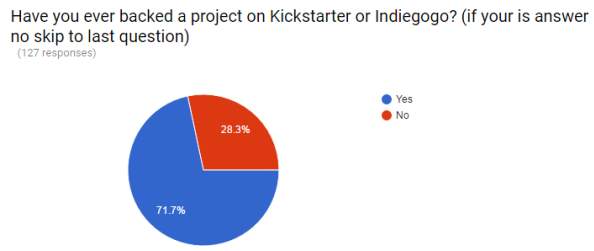
Responders were asked if they ever have backed a product on Kickstarter or Indiegogo
- 71.7% of responders (91) backed a product
- The rest 28.3% said that they have never backed a product thus these responders were not analysed
Question 2
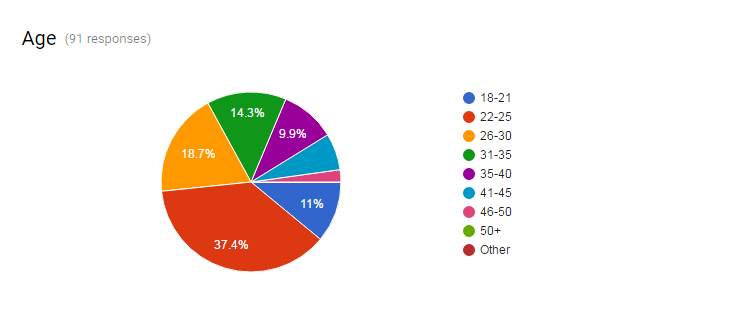
- 11% responders were between ages of 18-21
- 37.4% responders were between ages of 22-25
- 18.7% responders were between ages of 26-30
- 14.3%responders were between ages of 31-35
- 9.9% responders were between ages of 35-40
- 6.6% responders were between ages of 41-45
- 2.2% responders were between ages of 46-50
- 0% responders were between ages of 50+
Question 3

Regarding gender results were:
- 62.6% male
- 36.3% female
- 1.1% preferred not to say
Question 4
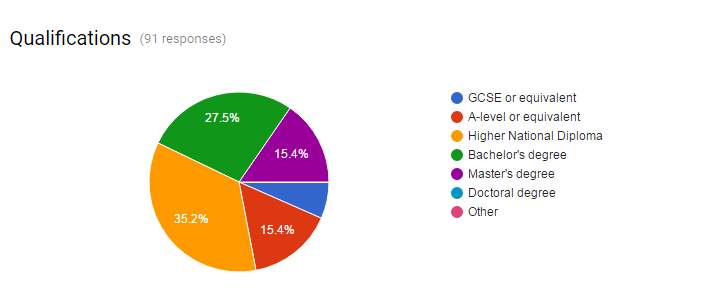
This question was used to analyse qualifications of responders
- 6.6% had GSCE or equivalent
- 15.4% had A- level or equivalent
- 35.2% had Higher National diploma
- 27.5% had Bachelor’s degree
- 15.4% had Master’s degree
- 6.6% had Doctoral degree
Question 5
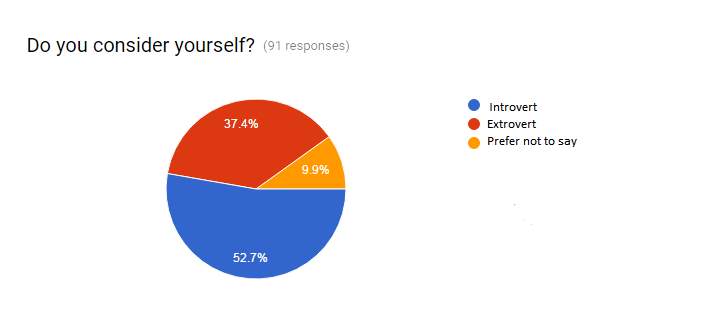
All responders were asked if they consider themselves as an introvert or extrovert and the results were:
- 52.7% said they consider themselves introvert
- 37.4% said they consider themselves extrovert
- 9.9% preferred not to say
Question 6
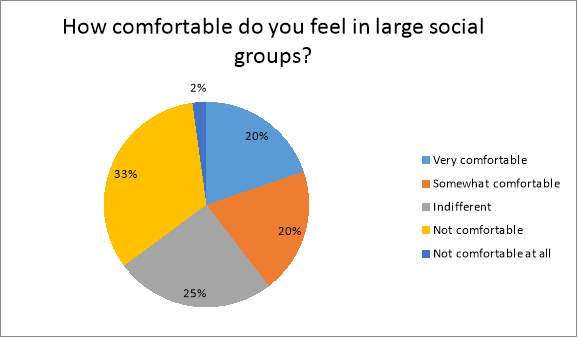
- 20% stated that they feel very comfortable
- 20% stated that they feel somewhat comfortable
- 25% stated that they feel indifferent
- 33% stated that they don’t feel comfortable
- 2% stated that they don’t feel comfortable at all
Question 7
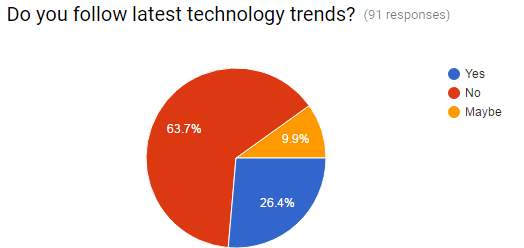
- 26.4% of responders said YES
- 63.7 of responders said NO
Question 8
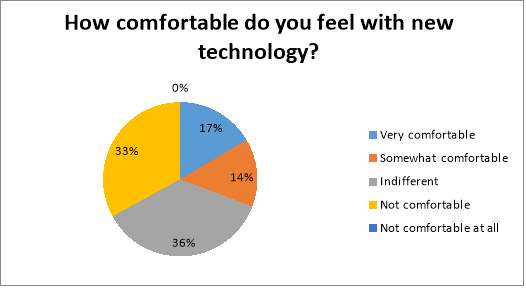
Responders were asked if they feel comfortable in large social groups and the results were:
- 17% stated that they feel very comfortable
- 14% stated that they feel somewhat comfortable
- 36% stated that they feel indifferent
- 33% stated that they don’t feel comfortable
- 0% stated that they don’t feel comfortable at all
Question 9
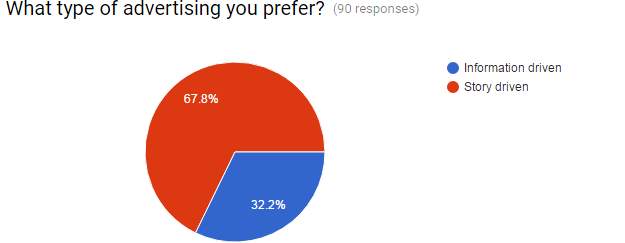
- 67.8% stated they prefer story drive advertising
- 32.2% stated they prefer information drive advertising
Question 10
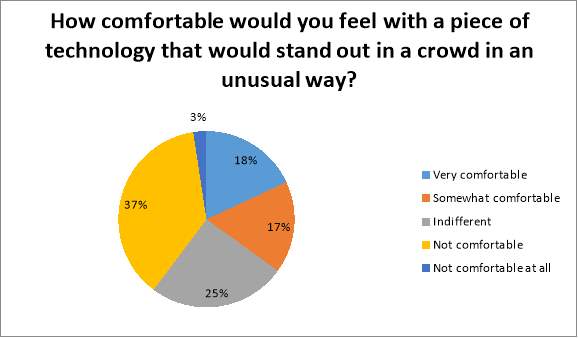
- 18% stated they feel very comfortable
- 17% stated they feel somewhat comfortable
- 25% stated they feel indifferent
- 37%stated they don’t feel comfortable
- 3% stated they don’t feel comfortable at all
Question 11
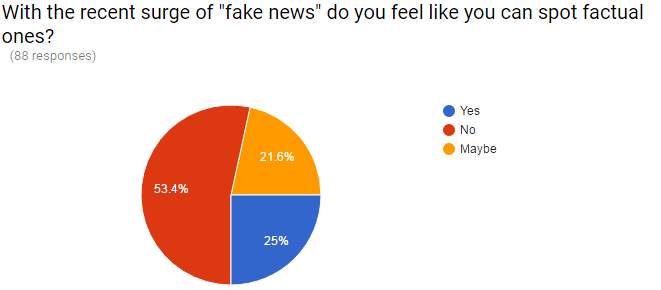
- 25% claimed that they can spot factual news
- 53.4% claimed that they cannot spot factual news
- 21.6% were not sure
Question 12
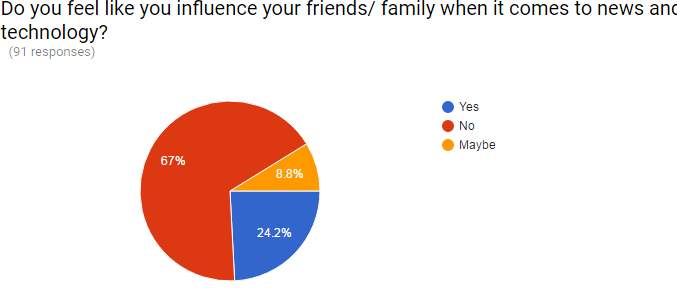
- 24.2% responders answered YES
- 67% responders answered NO
- 8.8 were not sure
Question 13
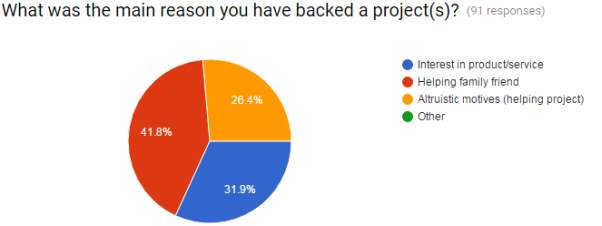
- 31.9% said they were interested in the product/service itself
- 41.8% said they were helping friends/family
- 26.4% said they helped because of altruistic motives
Question 14
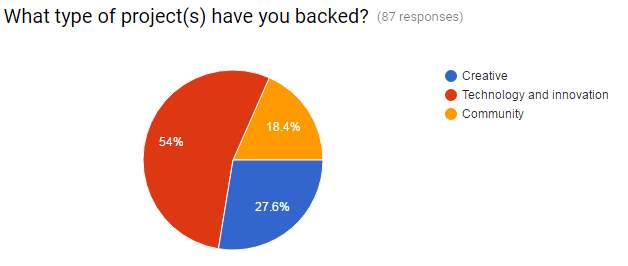
- 27.6 reported that they have backed creative type of projects
- 54% reported that they have backed technology or innovation related projects
- 18.4% reported that they have backed community based projects
Question 15

- 15.2% donated £1-£20
- 18.5% donated £21-£51
- 20.7% donated £51-£100
- 20.7% donated £101-£200
- 13% donated £201-£300
- 5.4% donated £301-£400
- 3.3% donated £401-£500
- 3.3% donated £500+
Question 16
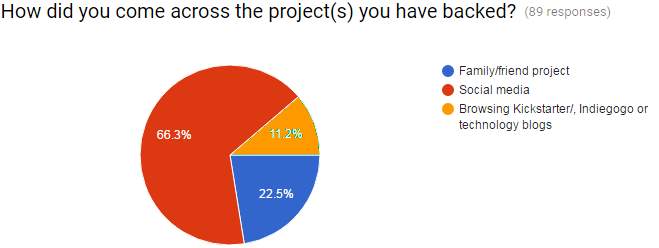
- 22.5% of responders found out about the project from family/friends
- 66.3% of responders found out about the project from social media
- 11.2% of responders found out about the project when browsing Kickstarter, Indiegogo or technology blogs
Question 17
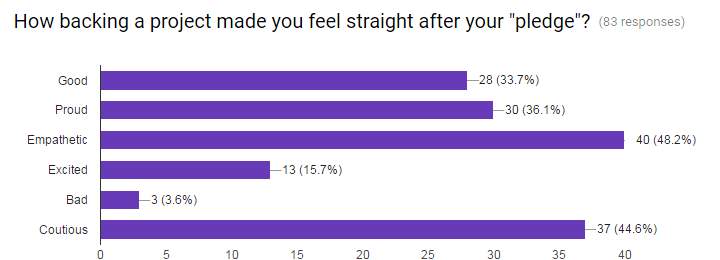
- 33.7% of responders claimed that it made them feel good
- 36.1% of responders claimed that it made them feel proud
- 48.2% of responders claimed that it made them feel empathetic
- 15.7% of responders claimed that it made them feel excited
- 3.6% of responders claimed that it made them feel bad
- 44.6% of responders claimed that it made them feel cautious
Qualitative findings
The qualitative data gathered through interviews, enabled participants to offer their personal and subjective viewpoints regarding crowdfunding platforms and their involvement in them.
All the participants to the interviews had been engaged in backing crowdfunding projects and all of them had pledged to technology related products. The interviews show how in the process of pledging, backers are more influenced by the story are telling nature of advertising. Through the responses given, pledgers stated that they do not follow technology trends and most products backed were chosen out of necessity. The experience they had while being involved in crowdfunding projects did not appear to be highly tailored to the possibility of future pledges. Based on their social circumstances, none of them appeared to be influencers. The interviews helped make sense of the participant’s personalities and interests, where all of them were introverts. Regarding their education level, one of them was in the process of finalising a BA course, one already had obtained a BA diploma and the third had an equivalent for a college degree. The interviews also helped pinpoint their emotions raised from the process of pledging to projects which overall was a satisfying experience, but did not imply a high level of enthusiasm.
Analysis
Objective 1. Are the majority of crowdfunding project backer’s innovators?
The quantitative and qualitative data gathered indicate that respondents are characterised by various attributes defined by their involvement in society, the level of their education, motivation to back projects etc. Relating these attributes to Rogers and Chamorro-Premuzic, 2013) ‘s depiction of what innovators are, the literature review stands as a theoretical comparison to the viewpoints of participants.
In the theoretical framework, innovators are synonymic to highly extrovert people with “cosmopolite social relations” (Rogers,2003) , equipped with a venturesome spirit and a flair for seizing opportunities. They manage to influence others into adopting new products, are highly educated individuals and are not afraid to take risks. This is something the nature of this research fails to prove due to the limited sample sizes and time constraints. From all the responses gathered, it can be concluded that in the case of this investigation, the majority of participants failed to meet the criteria of innovators. Based on the information provided, participants are better defined by opposing characteristics, appearing to be reasonably educated people that prefer not to stand out in a crowd. Moreover, the majority describes themselves as introverts, with low regards to the advancements of technology drawn from a response to the question regarding their interest in technology trends which states that “No, not really. I don’t use technology and I am not obsessed with it. I know what’s out there” (Interview2)
In addition, more than 50% of respondents pledged less than £100.00, action which defies the risk prone spirit of innovators. One of the interview answers states that “: I only look for technology when I’m facing a problem, hence the cable and adapter, but I don t particularly think I stay up to date with it. I mean, I think there’s too many so called inventions out there these days.” (Interview 2)
Furthermore, the majority of interview respondents and survey participants were made aware of the campaigns either through friends/family or advertising. This further proves that in the process of analysing the data, most of the participants were influenced into backing projects rather than vice-versa, attitude which is expected from innovators. One voiced opinion clearly states “I think I am more influenced by my friends than they are by me “(Interview1)
Objective 2. To what extent do marketing strategies influence backers?
Referring to the literature review, it has been established than one major element used by marketers when promoting projects is done through the launch of promotional videos. Based on the responses gathered from interviews, it appears that this marketing strategy highly influenced backers. One participant states that “Oh I just remembered! My friend forwarded the video of Oculus rift, that’s how I found out about it” (Interview1). Based on the survey outcomes, it was concluded that for the most part, advertising done through social media had the biggest influence over the decision to back projects. 66.3% of respondents said they discovered the projects through social media while only 11.4% found out about the project through Kickstarter, Indiegogo or technology blogs.
Even when determining that crowdfunding projects promise the delivery of new products which aren’t available anywhere else on the market, respondents were affected in a negative way, where either the delivery time was postponed several times or once arrived or the product did not fully respond to the characteristics promised in the funding stage. One respondent stated that “Not that it doesn’t work at all, it’s just it’s not what they promised” . (interview3) This aspect further influenced one other respondent to say that “Looking back I think I made a mistake, should have bought from the shop. Oh well” (interview2), which after more than a year from pledging, was still waiting for the product to arrive. However, as per Rees –Mogg’s suggestion that one of the most important elements is constant communication between pledgers and fundraisers, all interviewees mentioned that crowdfundees did keep the dialogue open, reassuring pledgers their products will arrive.
One other aspect that stands as proof for the influence of marketing strategies over users was the fact that only 24% of respondents were able to differentiate between deceptive advertising (meant to overestimate the capabilities of projects) and fake news, leaving the other 76% to state they are not sure or simply can’t see the differences. Even from the interviews users, appear to be conflicted as they aren’t sure if what they see is advertising or fake news. One interview participant stated that “All these fake news scare me a bit, I don’t know who to believe anymore” (interview 2).
Objetive3. What motivates crowdfunding pledgers?
The survey findings show that only 31.8% of respondents backed a product because they were interested in the product/ service itself and that the majority helped friends/family. Moreover, 26.4% claimed they had altruistic motives behind their support. Rick (http://www-personal.umich.edu/~prestos/Consumption/pdfs/RickCryderLoewenstein2007.pdf ) highlighted that people are not immune to emotional influences and the perceived emotional benefits play a huge part. This is seen from the survey data where 48.2% of participants said they felt empathetic after funding a project. Furthermore, 36.1% said they felt proud and 33.7% said they felt good. As mentioned in the literature review, positive emotions encourage and strengthen community driven behaviour. During the interview, one of the participants said: “I could have bought wireless earbuds from the shop but I decided to help the project organisers” proving what Rick (2017) already established, that when helping to fund a project, positive emotions are evoked. Qualitative data also pointed out that the need to resolve the perceived problem was a huge motivator for backers. One example that can be used here is the testimony of the second interviewee who referred to Kickstarter out of necessity. Even after establishing that for the most part, people pledge to projects out of a philanthropic premise, having at hand the exchange between money pledged and rewards becomes a reassuring factor for supporters but not a decisive one. As it can be withdrawn from the interviews, although initially proud of being able to help others, backers still felt suspicious or sceptical about the outcome of their crowdfunding venture. This is highly explained by the statement of one interview participant who mentions that “I felt excited and proud for helping someone fulfil their dream but at the same time cautious, as I have never used Indiegogo. Now I will stay away from these so called start-ups.”
Conclusion
The scope of this research paper was to determine if in the crowdfunding sphere participants can be classed as innovators or marketing targets.
The investigation helped formulate the steps that needed to be taken in order to verify the validity of the paper’s subject. It has been determined what innovators are and what their status in relation with innovation is. It delivered academic standing points applicable to marketing strategies and the socio cultural aspect that differentiates innovators from average crowdfunding platform users. By testing the theoretical standing points against the outcomes revealed from gathering and analysing quantitative and qualitative data, it has been observed that for the most part, as Rogers Everett affirms, only a limited number of individuals can see when and where innovations occur. The findings of this study actually proved that crowdfunding platforms hold the same place in society as any other marketing platforms. From the responses collected (from both the survey and interviews), it can be stated that more often than not, individuals tend to fall into the traps of marketers set in place to idealise products. This results into an overabundance of products which are far from being innovative but since they are advertised as such, everyday backers sometimes can’t tell the difference. Due to the time constraints and limitations of this study, the research can only be classed as a first step into determining the standing point of crowdfunding pledgers, where if incorporated in a larger study with a higher number of samples, the findings would potentially show the actual percentage of innovators within the crowdfunding sphere.
Cite This Work
To export a reference to this article please select a referencing stye below:
Related Services
View allRelated Content
All TagsContent relating to: "Marketing"
Marketing can be described as promoting and selling certain products or services to meet the needs of the customer. Tasks involved with Marketing include market research, content creation, advertising, and more.
Related Articles
DMCA / Removal Request
If you are the original writer of this dissertation and no longer wish to have your work published on the UKDiss.com website then please:




